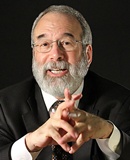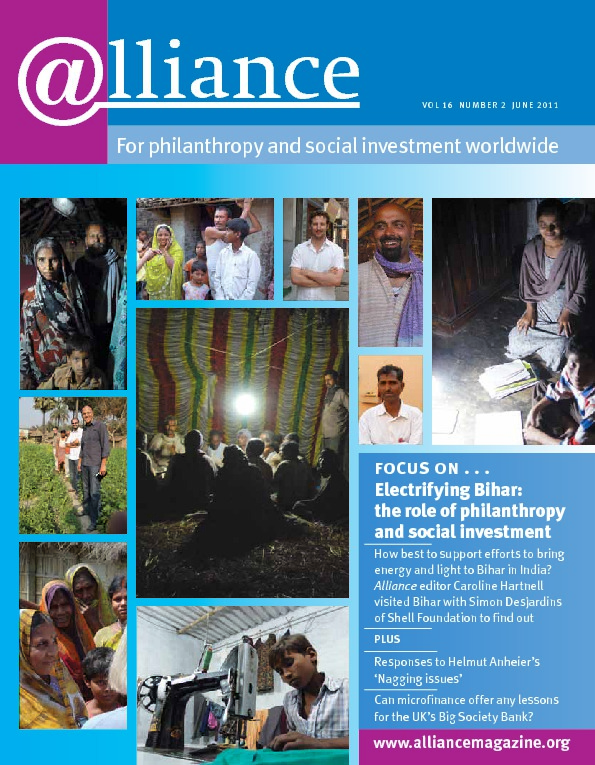Most people probably think that to provide economic opportunity to people in the developing world, you have to make some form of financial transaction which may or may not produce a financial return, or at least to relinquish temporary control over a portion of your assets. Not so. MicroCredit Enterprises (MCE) has devised a guarantee system that involves neither a donation nor an investment, not even the moving of money. Moreover, the ripple effects of each guarantee are such that each guarantor can improve the lives of some 15,000 people, MCE founder Jonathan Lewis explained to Alliance.
 Guarantees are nothing new, of course. The more traditional form of their use in development is as follows: someone in the developed world guarantees borrowing in the developing world. This helps establish a relationship between the borrowers − typically non-profits, social enterprises or small businesses − and the local banking system, which might not otherwise deal with them. The system also means that currency risks are removed: the guarantor’s funds remain in the guarantor’s country.
Guarantees are nothing new, of course. The more traditional form of their use in development is as follows: someone in the developed world guarantees borrowing in the developing world. This helps establish a relationship between the borrowers − typically non-profits, social enterprises or small businesses − and the local banking system, which might not otherwise deal with them. The system also means that currency risks are removed: the guarantor’s funds remain in the guarantor’s country.
A ‘Lloyd’s of London names’ for the developing world
MicroCredit Enterprises (MCE) has a different model. Starting with a guarantee of $1 million from each guarantor – high net worth individuals, foundations, non-profit institutions or corporations – MCE borrows $500,000 from commercial banks for each $1 million guarantee. These banks would not lend to MCE in its own right because it has no assets and no credit rating, but they will lend on the strength of the guarantors’ backing and superior credit ratings.
This innovative social finance model is similar to the Lloyd’s of London names idea, but with the aim of reducing poverty. The pool of guaranteed funds is then distributed across 19 countries. In effect, the extremely creditworthy guarantors, who commit themselves for at least 18 months, are guaranteeing loans to very poor women living on $1 a day or less, who have absolutely no credit rating, but who have a remarkable 97 per cent repayment rate. MCE is the intermediary organization.
The crucial difference from the traditional form of guarantee is that, under the latter, the guarantors have to place money in a bank where it forms a line of credit to be drawn on by the developing country bank if their borrowers default. In MCE’s model, the guarantors’ money stays with them to invest as they like, unless they are called on in case of a default by an overseas microfinance institution (MFI) – which has happened only once in six years, in Azerbaijan. In that case, all the guarantors paid up within 30 days, each of them taking a proportion of the first loss, a negligible and tax-deductible $7,600 per guarantor.
At the moment MCE has $25 million in loans to MFIs in 19 countries on four continents. As one of the guarantors, Dorothy Largay, founder of the Linked Foundation, points out, ‘a high net worth individual or a foundation, without moving any money, can provide a half million dollars’ worth of lending to the developing world.’
As the pool grows, so the risks diminish. When the scheme was launched in 2006, there were seven guarantors. Now there are over 50, so each bears less than 2 per cent of any loss and losses are very rare (less than 1 per cent since MCE was launched). The target is to reach 100 guarantors, providing MCE with a $100 million guarantee pool, reducing the risk exposure per guarantor to just 1 per cent. If there is a default and they have to pay up, the payment is tax-deductible. In the case of a foundation guarantor, the payment will be a grant.
A holistic approach
While guarantors are in a common risk pool, the banks that lend to MCE are in a common lending pool: they lend to MCE and MCE pays them back regardless of the use of the loans. Because of this, as Lewis explains, ‘MCE is able to be more forward-leaning in its lending’. It can, for example, give priority to smaller MFIs in rural areas where there is a higher incidence of extreme poverty. ‘It also enables us to pursue our other aims of providing the lowest interest rates possible and supporting the whole person’ – combining microfinance with health and education provision, women’s empowerment and financial literacy.
With low risk, minimal effort and high social returns, the guarantee is a good and relatively simple way for interested individuals and organizations to use what MCE describes as ‘passive capital’ for the benefit of the poor in developing countries.
For more information
http://www.mcenterprises.org or contact Jonathan Lewis, founder and board chair, at JLewis@MCEnterprises.org




Comments (0)